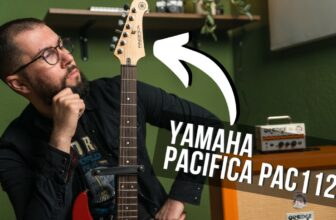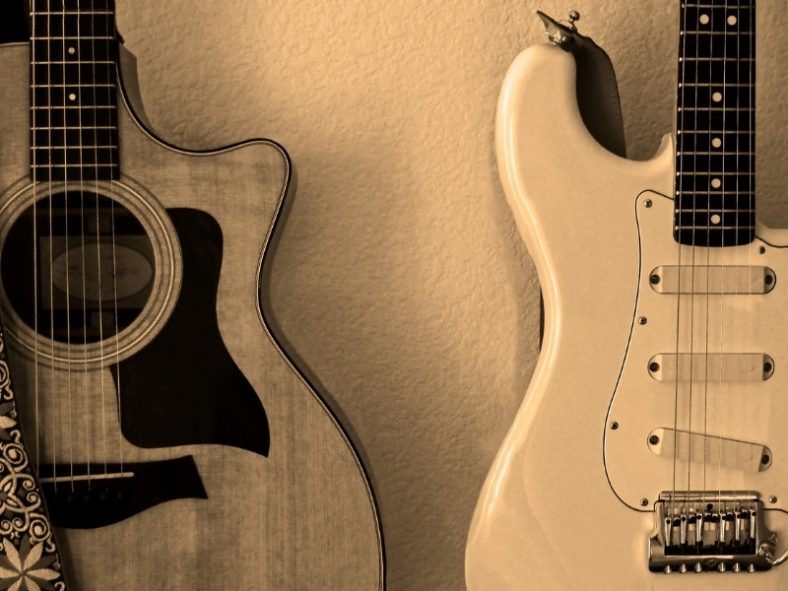
Getting familiar with the parts of a guitar is very beneficial and essential for every guitarist. It helps beginners know what to look for when buying guitars, and experienced players recognize better ones. Knowing the guitar skeleton will provide insight and knowledge to make quality distinctions.
This guide will help you understand every part of acoustic and electric guitars, so you know what to look for when shopping for one.
Contents
Standard Guitar Parts (acoustic and electronic)
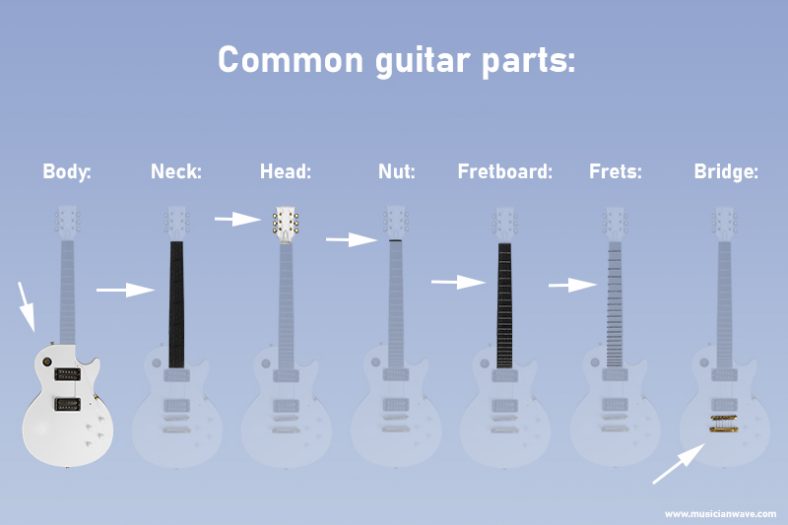
- Body. The body of an acoustic guitar is made up of the back, sides, and soundboard. Although the sides and the back play a role in a guitar, the soundboard vibrates to produce sound. In an electric guitar, the body serves as a place to embed pickups so they can convert vibrations of the strings into an electrical signal.
- Neck. The neck of a guitar is a piece of wood attached to the body, it is the playable area of the guitar, and it’s very important. Many different guitar necks are varying in size, shape, and type of wood used.
- Headstock. The headstock is part of the neck and not a separate piece. The headstock is a part of a guitar that helps anchor the guitar strings, and it’s where you tune your guitar.
- Nut. The function of the nut is to support the strings as they cross from the headstock to the neck. It helps with transmitting vibrations to the neck, and because of them, you can play open strings.
- Fretboard. The fretboard is one of the essential parts you physically touch on the guitar. It allows you to place fingers on the neck, and it’s the part that holds the frets.
- Frets. Frets serve as a tension point that the guitarist can use to alter the note of the string that’s being played. Different guitars have a different number of frets on them, and there is a difference between acoustic and electric guitar frets.
- Bridge. The bridge is a guitar part that sits on the body and supports the strings, it is also responsible for transmitting the vibrations of the strings to the soundboard.
Acoustic Guitar Parts
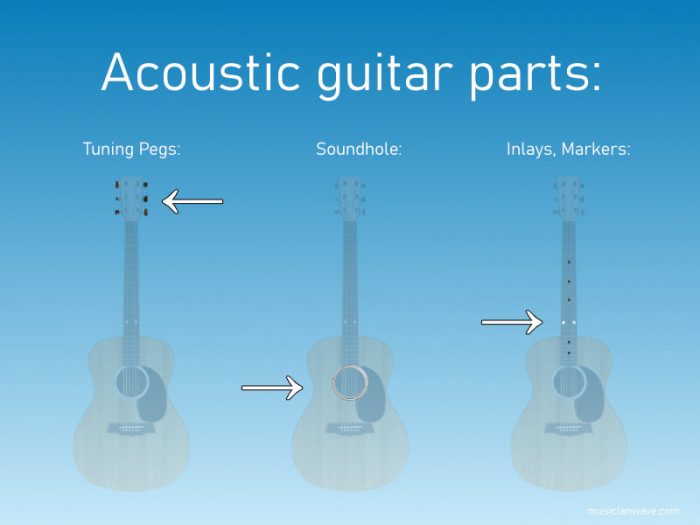
- Tuning Pegs. The tuning pegs play a vital role in the guitar’s sound. They give you the ability to adjust string tension, therefore changing the pitch of the strings.
- Sound hole. The sound holes’ primary purpose is to amplify the sounds you play on the acoustic guitar. They aid the vibration to increase the volume, and it’s the part that facilitates all the resonance.
- Inlays, markers. The inlays or markers are the dots on the guitar’s neck. They are there to help guitarists better locate the right notes on the fretboard.
Electric Guitar Parts
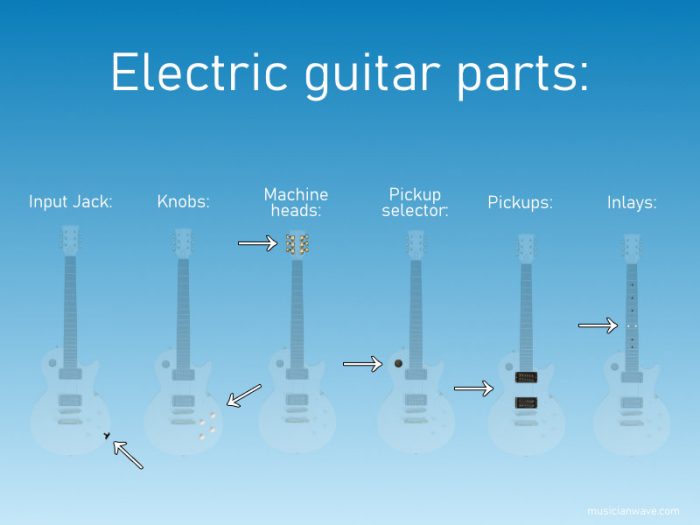
- Machine heads. Where an acoustic guitar has tuning pegs, the electric guitar uses machine heads. They basically serve the same function as tuning pegs, though there are many types of different machine heads available depending on the guitar, model, etc.
- Inlays. The inlays on an electric guitar have the same function as on an acoustic guitar. Often, people like to change the look of inlays on electric guitars for a more aesthetically pleasing look.
- Pickups. The pickups are an essential part of the electric guitar, they are responsible for converting vibrations from the strings into electricity. They also influence the volume and the dynamics of the instrument.
- Pickup selector. The pickup selector is a switch connected to the pickups and it gives you the ability to change pickups or choose different combinations to play.
- Knobs. There are commonly two types of knobs on an electric guitar: the volume knob and the tone knob. The volume knob gives you the ability to determine how loud the output is, while the tone knob filters the amount of treble output.
- Output Jack. The output jack on an electric guitar is the part where you plug in the cable that goes to the input of your amplifier or interface. It is responsible for transferring the signal from the guitar to another device that can work out the electrical signals.
Other/Smaller Guitar Components
- Strings: The string’s purpose is to vibrate and produce sound. Guitars with six strings are most common but there are guitars with more. Each guitar string is tuned to a particular musical note.
- Tremolo: If the string’s purpose is to vibrate, the tremolo is there to change the pitch of the vibrations by altering the tension of all strings at once.
- Truss rod: The truss rod is a metal shaft located in the neck of the guitar and runs all the way through it. It is there to help the neck, so it doesn’t bend from the pressure.
- Pickguard: The only function that the pickguard has, as the name suggests, is to protect the guitar’s finish while playing with a pick.
- Strap button: There are two strap buttons on a guitar’s body and their purpose is to hold the guitar strap.
What Are Other Types Of Guitars?
Besides acoustic and electric guitars, which are most common, there are many different types of guitars out there. Each serves a different purpose and they usually have a specific thing that is different from the traditional guitars.
First, there are MIDI guitars. A MIDI guitar has a fretboard scanner built-in that detects in real-time which notes you are playing through the electrical contact of the string and the fretboard. What’s unique about MIDI guitars is that they are entirely software-based. Therefore they can produce a plethora of different sounds.
Carbon fiber guitars are a relatively new type of guitar in the industry. The most significant difference between traditional acoustic and electric guitars is that they are made of carbon fiber. They are usually lighter and are more resistant to intense temperature and humidity changes, which is a big deal. Wooden guitars don’t like extreme temperatures and humidity changes, so carbon fiber guitars make sense.
Double neck guitars also solve another problem, especially for live performances where the guitarists can easily switch instruments without having to strap on another guitar, therefore saving time. They are mainly used when a guitarist wants to switch to a different tuning quickly.
Conclusion
Whether you are a new guitarist who wants to expand your knowledge about guitars or maybe build one yourself in the future, knowing all the parts that create a guitar is a must. Every single thing that is integrated into a guitar has a particular function in producing the whole sound. After studying the guitar and how it’s made, you can also improve and find the right sound that works for you.

